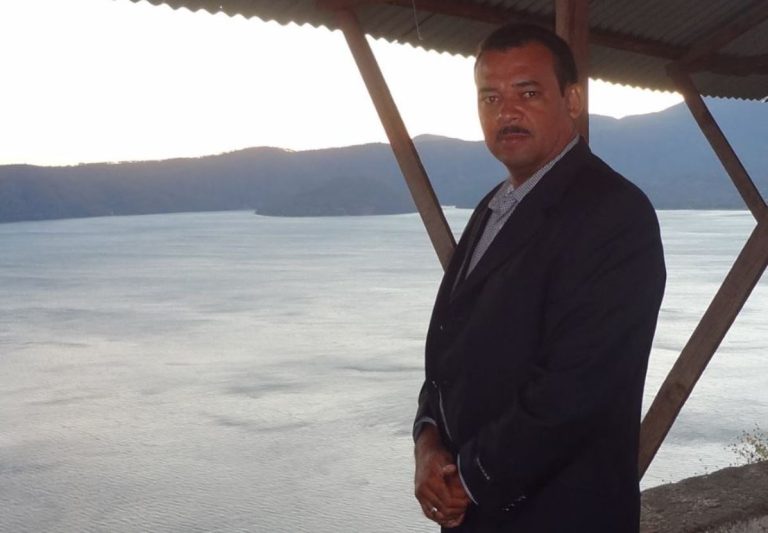16 de junio 2020

Children of Exile: The Births “Sowing Hope” in the Camp of Nicaraguan Farmers

PUBLICIDAD 1M
PUBLICIDAD 4D
PUBLICIDAD 5D
The journalist, who also suffered constant harassment from the regime, died after two weeks in the hospital amid Nicaragua’s grave public health crisis

Journalist Sergio Leon Corea, director of the Bluefields-based radio station La Costenisima, died on Sunday, June 14, at the age of 52. Those close to him indicated that the journalist and sociologist first presented symptoms of Covid-19 in the last week of May. His condition was aggravated by other chronic health conditions, and on June 2nd he was admitted to Bluefield’s “Ernesto Sequeira” Hospital. His health had worsened by the afternoon of June 13th, and early Sunday morning he was connected to a ventilator. Unfortunately, he passed away several hours later.
Leon had recently had a legal complaint filed against him for slander and falsehoods, on the part of people tied to the Ortega-Murillo regime. He had requested a postponement of the assigned date for appearing before a judge.
The journalist, and the radio station La Costenisima, founded in 2001, led an effort to report on the Nicaraguan people’s protests during the 2018 April rebellion, as well as on the violent repression unleashed by the government of Daniel Ortega and Rosario Murillo against the unarmed citizens in the Caribbean region.
Journalist Carlos Fernando Chamorro, director of the informational website Confidencial and the internet-based television news program Esta Semana, recalled that “the Inter-American Commission for Human Rights granted Sergio Leon precautionary protective measures to safeguard his physical integrity, measures which the regime never actually complied with. This didn’t prevent the journalist from maintaining intact, until his last breath of life, his commitment to reporting the truth.”
In effect, during the 173rd session of the Inter-American Commission for Human Rights, held on September 25, 2019, the reporter denounced the fact that the Nicaraguan State had not complied with the precautionary measures the Commission had dictated to protect him and his family, nor had they investigated the threats against him.
At that time, Leon denounced “a strategy to drastically affect La Costenisima”, whereby sympathizers with the party in power and government functionaries ordered their followers not to listen to the station, and prohibited it from being broadcast in the public institutions.
“The neighborhood and community [FSLN party] structures keep an eye on the homes in their area to find out who is listening to this station, especially their news program ’Tras la Noticia [“Behind the News”]. The population are forced to listen to our news programs at the lowest possible volume, to avoid having members of the government structures identify it and later take reprisals against them,” Leon declared at that time.
The journalist told of: “the intimidation and constant police vigilance of the radio’s installations, as well as my home”, in addition to the existence of a police record in which he’s accused of being: “from the opposition line; publishing fake news, creating collective confusion and panic in the population, and broadcasting subversive vignettes promoting chaos and destabilization.”
The attacks included attempts to block the station’s website, as well as intimidating graffiti painted on the station’s walls and in points close to his house.
When the news of his death was released, the radio program Onda Local [“Local Wave”] broadcast a live videocall in which his colleagues and those who knew him remembered him as a noble, charismatic, courageous, knowledgeable man, committed and always willing to assist his colleagues; an excellent journalist, loyal to the ethical principles of his profession, even amid the increasing calls to be careful.
Chamorro said of Sergio Leon, known as “Bam Bam”: “He was first and foremost a great human being; a journalist who was a symbol of commitment to truth and democracy in the South Caribbean region of Nicaragua, and above all, an example of the resistance of the independent press in the face of the dictatorship’s persecution, which stalked him up until the last moment, when Sergio attempted to knock down the wall of censorship during the public health crisis.
In Bluefields, the station he directed broadcast his funeral, in coordination with the media network Voces en Libertad [“Voices in Freedom”]. The ceremony took place on a cloudy day under light rain. Over 3,700 people listened online to the final honors.
His casket, painted in spotless white, was buried at three PM, covered by a blue and white flag, whose clear colors were the last to disappear under the dirt, while a little later the National Anthem was sung.
Rest in Peace, Sergio!
Archivado como:
PUBLICIDAD 3M
Periodista nicaragüense, exiliado en Costa Rica. Durante más de veinte años se ha desempeñado en CONFIDENCIAL como periodista de Economía. Antes trabajó en el semanario La Crónica, el diario La Prensa y El Nuevo Diario. Además, ha publicado en el Diario de Hoy, de El Salvador. Ha ganado en dos ocasiones el Premio a la Excelencia en Periodismo Pedro Joaquín Chamorro Cardenal, en Nicaragua.
PUBLICIDAD 3D